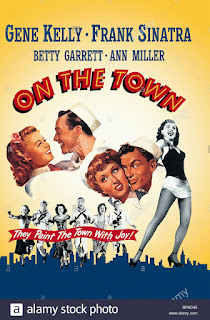Plot: Based on a Broadway Play, Three Sailors with a 24 hour Leave, find fun and Romance in New York City
Stars: Gene Kelly, Frank Sinatra, Vera-Ellen, Ann Miller
Co-Directors: Kelly - Donen
Positives: Cast, Location shots, Cinematography, Dancing, Fast paced story, Title Song
Minuses: Mediocre Songs, Not much of a Plot,
Background
Supposedly Gene Kelly's favorite musical,
On the Town was a popular ground-breaking musical in 1949. The use of believable characters in a real location (as opposed to a sound stage) had been done before but never to such an extent or with such impact.
The MGM brass were against filming in NYC, wrongly thinking Culver City was good enough. Today, the location shots of 1949 New York, are one the film's chief attractions.
Leonard Bernstein's songs in the Broadway play received mixed reviews. Some loved his experimental music, while other reviewers were less impressed. One wrote
" ...a musical needs some music to got with its lyrics. Words that rhyme and have a Rhythm do not necessarily make a lyric, nor do 32 bars full of notes, necessarily make a song." Louis B. Mayer, agreed with the critics and the Bernstein's songs were junked and new one's added. The substitution has been criticized, but after listening to Bernstein's songs on Youtube - I have to agree with Mayer. Except for "
I can Cook too" there's not a great song in the bunch. The only mistake was in not adding better songs.
Judging by its IMDB rating (7.6 based on 13,000 votes)
On the Town still seems to be fairly popular. No doubt the casting of Frank Sinatra has something to do with it. Certainly, Sinatra was responsible for a significant portion of film's 1949 success. While filming in NYC, Sinatra drew crowds where ever he went. And he was paid accordingly. Old Blue Eyes made $130,000 to Kelly's $42,000 (which includes his additional "Co-Director" salary) despite his character getting significantly less screen time then Kelly's.
Evaluation
So what do I think? On 2nd viewing, I'm much more impressed. I saw it on my Big Screen TV and
On the Town really needs to be seen on as big a screen as you can manage. The film looks fantastic, and even though the songs (except for "Its a Wonderful Town") were mediocre, the cast's energy and good humor put them over. People focus on Kelly and Sinatra, but its the actresses who make the film enjoyable. Betty Garrett is hilarious as the man-hungry taxi driver out for Sinatra, Ann Miller sets the screen on fire with her tap dancing and great gams, and Vera-Ellen never looked lovelier or danced better. The story isn't much (its seems very similar to
Anchors Aweigh) but Donen-Kelly keep the pace up. Its definitely one of Gene Kelly's best films.







